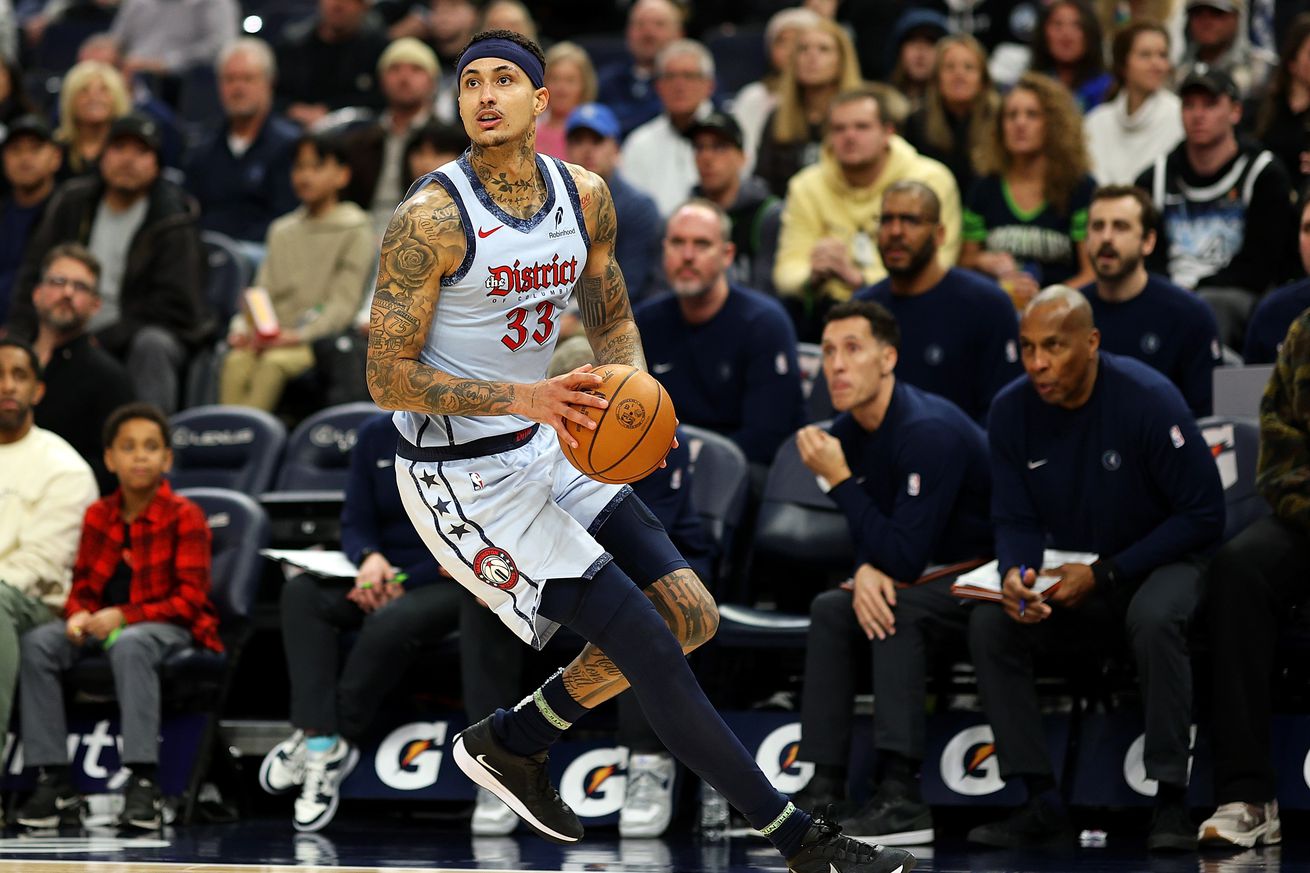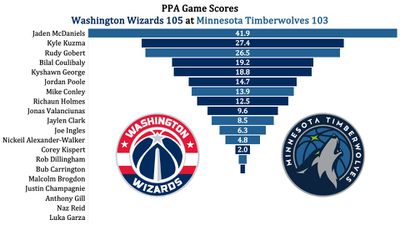
Recap plus stats, commentary, analysis.
With a 105-103 win over the Minnesota Timberwolves, the Washington Wizards sent a strong message to the NBA — you do NOT beat the Wizards 17 times in a row.
It was a close contest throughout with the Wizards building leads followed by a Timberwolves rally. Washington led most of the way — leaping ahead by as much as 11 late in the third quarter.
The Wizards were up by six to start the fourth quarter, and it looked early in the period like that would be the high point. Minnesota made their first seven shots of the period and took a three-point lead (their biggest of the night). Washington battled back as the Timberwolves’ injury-depleted roster seemed to sputter.
Washington made the final minute an adventure. They entered the stretch with a one-point lead, and then scored twice to go up 105-100 with 20 seconds to play. And then…Bilal Coulibaly fouled Mike Conley on a three-point attempt, and Conley hit all three free throws.
Still, up two with 16 seconds to play, it seemed like Washington merely needed to inbound the ball and make some free throws. Their first sideline out-of-bounds play (SLOB) involved 21-year-old rookie Kyshawn George as the inbounds passer. He missed Poole cutting free until it was nearly too late, and Nickeil Alexander-Walker nearly stole the ball.
Head coach Brian Keefe changed the play call and deployed Kyle Kuzma as the inbounder. The 29-year-old veteran butchered a pass to Jonas Valanciunas, and Alexander-Walker actually stole the ball. Minnesota then got Alexander-Walker an open three with three seconds on the clock, which he missed, and so the Wizards escaped with the two-point win.
The Wizards got some health breaks that helped them snap the 16-game skid. The Timberwolves were missing Anthony Edwards, Julius Randle, and Donte DiVincenzo to start the game, and then lost Naz Reid to a finger injury. That quartet is a big chunk of their offense, and Minnesota struggled to generate points against Washington’s 30th ranked defense.
That said, it was Washington’s seventh win of the season, and just their second victory on the road in the 2024-25 campaign.
Bright Spots for the Wizards?
- Kyle Kuzma snapped out of his funk for 31 points and 8 rebounds. Kuzma’s offensive efficiency was solid — 13-24 from the floor, 5-10 from three, and just 2 turnovers. His offensive rating (points produced per possession x 100) was 115. He scored 18 points in an explosive second quarter, and 9 points in the final period.
- Bilal Coulibaly turned in a solid performance — 14 points, 4 rebounds, 5 assists, and solid defense on the perimeter. He produced 2 steals and 2 blocks.
- Kyshawn George was aggressive on offense, and the team defense was at its best when he was in the game.
- Poole hit shots early and had a couple nice blocks.
- Richaun Holmes — playing because of the injury to Alex Sarr — provided energy and hustle. He had 6 points, 3 rebounds, 3 assists, and one dive on the floor for a loose ball and then win the jump ball play.
- Malcolm Brogdon shot poorly (1-6) in his return from a foot injury, but tallied 5 rebounds and 4 assists in 21 minutes.
Four Factors
Below are the four factors that decide wins and losses in basketball — shooting (efg), rebounding (offensive rebounds), ball handling (turnovers), fouling (free throws made).
The four factors are measured by:
- eFG% (effective field goal percentage, which accounts for the three-point shot)
- OREB% (offensive rebound percentage)
- TOV% (turnover percentage — turnovers divided by possessions)
- FTM/FGA (free throws made divided by field goal attempts)
In the table below are the four factors using the percentages and rates traditionally presented. There’s also a column showing league average in each of the categories to give a sense of each team’s performance relative to the rest of the league this season.
Stats & Metrics
Below are a few performance metrics, including the Player Production Average (PPA) Game Score. PPA is my overall production metric, which credits players for things they do that help a team win (scoring, rebounding, playmaking, defending) and dings them for things that hurt (missed shots, turnovers, bad defense, fouls).
Game Score (GmSC) converts individual production into points on the scoreboard. The scale is the same as points and reflects each player’s total contributions for an average NBA game. The lowest possible GmSC is zero.
PPA is a per possession metric designed for larger data sets. In small sample sizes, the numbers can get weird. In PPA, 100 is average, higher is better and replacement level is 45. For a single game, replacement level isn’t much use, and I reiterate the caution about small samples sometimes producing weird results.
POSS is the number of possessions each player was on the floor in this game.
ORTG = offensive rating, which is points produced per individual possessions x 100. League average last season was 114.8. Points produced is not the same as points scored. It includes the value of assists and offensive rebounds, as well as sharing credit when receiving an assist.
USG = offensive usage rate. Average is 20%.
ORTG and USG are versions of stats created by former Wizards assistant coach Dean Oliver and modified by me. ORTG is an efficiency measure that accounts for the value of shooting, offensive rebounds, assists and turnovers. USG includes shooting from the floor and free throw line, offensive rebounds, assists and turnovers.
+PTS = “Plus Points” is a measure of the points gained or lost by each player based on their efficiency in this game compared to league average efficiency on the same number of possessions. A player with an offensive rating (points produced per possession x 100) of 100 who uses 20 possessions would produce 20 points. If the league average efficiency is 114, the league — on average — would produced 22.8 points in the same 20 possessions. So, the player in this hypothetical would have a +PTS score of -2.8.

by Kevin Broom
